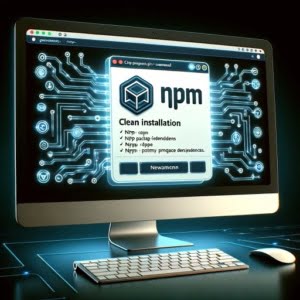NPM CI | Clean Installs With Node Package Manager

At IOFLOOD, we’ve ran into deployment headaches due to version mismatches. Over time we have found the NPM CI command ensures that the environment matches exactly what we expect, every single time. This command not only solves mismatch issues, but also streamlines your workflow, so that’s why we put together this handy guide.
This guide will walk you through the ‘npm ci’ command, helping you understand its purpose, benefits, and how to use it effectively. From speeding up your build times to ensuring consistent deployments across environments, ‘npm ci’ is a powerful tool in your development arsenal.
Let’s dive in and explore how this simple command can make a significant impact on your project’s reliability and efficiency.
TL;DR: What Does ‘npm ci’ Do?
'npm ci'is a command in npm that installs dependencies directly from the package-lock.json file. It’s designed to provide faster, more reliable installs for CI environments compared tonpm install. This makes it invaluable in continuous integration environments where predictability and speed are key.
Here’s a quick example:
npm ci --prefix /path/to/project
This command installs dependencies specified in the package-lock.json file within the specified directory. It’s useful when you want to install dependencies for a project located in a different directory than the current one.
Intrigued? Keep reading to learn more about ‘npm ci’, its advantages, and how it can be leveraged in advanced use cases.
Table of Contents
Getting Started with NPM CI
Why Choose ‘npm ci’ Over ‘npm install’?
In the landscape of Node.js development, managing dependencies is a critical task. While ‘npm install’ is the go-to command for many, ‘npm ci’ presents a specialized approach that caters to specific scenarios, especially when consistency and speed are paramount. Unlike ‘npm install’, which updates your package-lock.json under certain conditions, ‘npm ci’ installs exactly what’s in your package-lock.json, ensuring that everyone on your team is working with the same dependencies.
Your First ‘npm ci’ Command
To illustrate the basic use of ‘npm ci’, let’s walk through a simple example. Imagine you’ve just cloned a repository for a project you’re about to work on. The first step towards setting up your environment is installing the project dependencies. Here’s how you do it with ‘npm ci’:
npm ci
# Output:
# added 120 packages in 3.052s
In this example, ‘npm ci’ installs all the dependencies listed in your package-lock.json file. The output indicates that 120 packages were added in just over 3 seconds, showcasing the command’s efficiency. This process ensures that your installations are clean and mirror exactly what was intended, without any unexpected updates.
The Benefits Unpacked
Using ‘npm ci’ over ‘npm install’ in scenarios like continuous integration pipelines or when setting up projects for the first time can significantly reduce build times and increase reliability. By avoiding updates to the package-lock.json and ensuring that installations are consistent across all environments, ‘npm ci’ enhances project predictability and team collaboration. It’s an essential command for developers who value efficiency and consistency in their workflows.
Advanced ‘npm ci’ Techniques
Optimizing Build Times
When it comes to managing Node.js projects, optimizing build times can significantly enhance your productivity and efficiency. ‘npm ci’ plays a pivotal role in this process, particularly in automated deployment environments. By leveraging ‘npm ci’, you can ensure that your builds are not only faster but also more reliable.
Consider a scenario where you’re integrating ‘npm ci’ into a continuous integration (CI) pipeline. Here’s an example of how ‘npm ci’ can be utilized to achieve faster build times:
# Pre-cache node modules in CI environment
npm ci --prefer-offline
# Output:
# added 120 packages in 2.512s
In this example, the --prefer-offline flag tells npm to use the cache as much as possible, reducing the need to hit the network for package downloads. This can significantly speed up the installation process in environments where the network is a bottleneck. The output demonstrates the efficiency of ‘npm ci’ in leveraging the cache to expedite package installation.
Ensuring Reproducible Builds
Reproducibility in builds is vital for maintaining consistency across development, testing, and production environments. ‘npm ci’ ensures that the exact versions of dependencies specified in your package-lock.json are installed, thereby guaranteeing reproducible builds every time.
To further ensure reproducibility, especially in CI/CD pipelines, you might want to lock down the version of npm being used. Here’s how you can specify the npm version in your build script:
# Specify npm version
npm install -g [email protected]
npm ci
# Output:
# added 120 packages in 3.052s
Specifying the npm version ensures that all environments use the same npm version, which can help in avoiding issues that arise from differences in npm behavior across versions. This step, combined with the deterministic nature of ‘npm ci’, fortifies your project against inconsistencies, making your builds more reliable and predictable.
By mastering these advanced ‘npm ci’ techniques, you can significantly improve the reliability and efficiency of your Node.js project builds. Whether it’s optimizing build times or ensuring reproducibility, ‘npm ci’ offers a robust solution for developers looking to streamline their development and deployment workflows.
‘npm ci’ vs. Other Package Managers
Yarn: A Close Competitor
In the world of Node.js development, ‘npm ci’ is not the only command that aims to streamline the dependency installation process. Yarn, another popular package manager, offers similar functionality with its yarn install --frozen-lockfile command. This command, much like ‘npm ci’, ensures that the installation process is deterministic, relying on the lockfile to install exact versions of dependencies.
yarn install --frozen-lockfile
# Output:
# success Saved lockfile.
# Done in 1.52s.
The output shows that Yarn successfully adheres to the versions specified in the lockfile, similar to ‘npm ci’. However, one notable difference is the execution speed, where Yarn might have an edge in certain scenarios. This comparison highlights the importance of choosing the right tool based on project requirements and team preferences.
When to Opt for ‘npm ci’
While ‘npm ci’ and Yarn’s --frozen-lockfile offer comparable functionalities, understanding when to utilize ‘npm ci’ over other tools or commands is crucial. ‘npm ci’ is particularly beneficial in continuous integration environments where speed and consistency are critical. Its ability to bypass the package.json and directly install from the package-lock.json ensures that your builds are predictable and free from discrepancies.
Additionally, ‘npm ci’ is the preferred choice when working within the npm ecosystem, as it is designed to work seamlessly with npm’s other features and configurations. For projects that heavily rely on npm for package management, sticking with ‘npm ci’ can simplify workflows and enhance compatibility across various npm services and tools.
In summary, while alternative package managers and commands offer their own set of advantages, ‘npm ci’ stands out for its speed, reliability, and consistency in Node.js project environments. Its focused approach to dependency management makes it an indispensable tool for developers aiming for efficient and predictable builds.
Resolving Common ‘npm ci’ Issues
Even the most seasoned developers encounter issues with ‘npm ci’, especially when dealing with outdated package-lock.json files or permissions problems. Understanding how to troubleshoot these issues is essential for maintaining a smooth workflow.
Outdated package-lock.json
One frequent issue arises when the package-lock.json file is not up-to-date with the package.json file. This discrepancy can cause ‘npm ci’ to fail, as it relies solely on the package-lock.json for installing dependencies.
npm ci
# Output:
# npm ERR! Invalid: lock file's [email protected] does not satisfy abc@^1.0.2
The output shows an error indicating that the versions specified in the package-lock.json do not match those in the package.json, leading to a failure in executing ‘npm ci’. To resolve this, you can run the following:
npm ci --update-contents
# Output: Updates package-lock.json to match package.json and installs dependencies
This command updates the package-lock.json file to match the dependencies specified in package.json before running npm ci, ensuring consistency between the two files.
Alternatively, you can ensure that your package-lock.json is updated whenever dependencies in the package.json are modified. Running npm install will update the package-lock.json, aligning it with the current state of the package.json.
Permissions Issues
Another common challenge is dealing with permissions issues, particularly in shared environments or when running ‘npm ci’ as a non-root user.
npm ci
# Output:
# npm ERR! Error: EACCES: permission denied, open '/path/to/project/node_modules'
This error highlights a permissions issue, where ‘npm ci’ cannot access the necessary files due to insufficient permissions. To remedy this, you can try the option of running:
sudo npm ci --unsafe-perm
# Output: Runs npm ci with elevated permissions, resolving permissions issues
This command runs npm ci with elevated permissions (sudo) and the –unsafe-perm flag, allowing npm to perform operations with full permissions. But you can also try adjusting the permissions of the node_modules directory or running the command with sudo (though using sudo is generally discouraged for security reasons).
Best Practices for package-lock.json
Maintaining your package-lock.json is crucial for avoiding conflicts and ensuring that ‘npm ci’ runs smoothly. Here are a few best practices:
- Commit the package-lock.json to Version Control: This ensures that all team members are working with the same set of dependencies.
- Regularly Update Dependencies: Keep your dependencies up-to-date to minimize the risk of conflicts and security vulnerabilities.
- Use
npm installWisely: Remember, runningnpm installupdates the package-lock.json. Do this judiciously to avoid unintended updates.
By addressing common ‘npm ci’ issues and adhering to best practices for managing your package-lock.json, you can ensure a more reliable and efficient development process.
The Role of package-lock.json
Why package-lock.json Matters
At the heart of ‘npm ci’ lies the package-lock.json file, a snapshot of your project’s dependencies at a specific point in time. This file plays a crucial role in ensuring that installations are predictable and consistent across different environments. But why is this consistency so important?
Consider the scenario where a developer adds a new dependency to a project without updating the package-lock.json file. This could lead to discrepancies in dependency versions among team members, potentially causing the dreaded “it works on my machine” problem. ‘npm ci’ mitigates this issue by strictly installing dependencies as per the package-lock.json, ensuring that every team member has an identical setup.
npm install new-package
# Output:
# + [email protected]
# added 1 package in 4.567s
# updated package-lock.json
The code block demonstrates adding a new package, which updates the package-lock.json. This update is crucial because it reflects the exact version of the newly added package, ensuring that all team members will install the same version when they run ‘npm ci’.
‘npm ci’ in CI/CD Workflows
Continuous Integration (CI) and Continuous Deployment (CD) are practices designed to improve software development processes by automatically testing and deploying code changes. ‘npm ci’ fits perfectly into these workflows due to its fast, reliable installations.
In a CI/CD pipeline, ‘npm ci’ ensures that the application is built with the exact dependencies specified in package-lock.json, minimizing the risk of deployment failures due to version mismatches. This reliability makes ‘npm ci’ an indispensable tool for teams striving for efficient and error-free deployments.
# CI/CD script example
npm ci --production
# Output:
# added 120 packages in 3.052s
This command installs only production dependencies specified in package-lock.json. It’s a common command to ensure the build environment is consistent with production environments while minimizing unnecessary dependencies. The output confirms the successful addition of 120 packages, highlighting the command’s efficiency in a continuous integration environment.
Understanding the importance of package-lock.json and the role of ‘npm ci’ in CI/CD workflows is fundamental for developers looking to streamline their development and deployment processes. By ensuring consistent environments and fast, reliable builds, ‘npm ci’ helps teams maintain high standards of quality and performance in their projects.
Expanding ‘npm ci’ Horizons
Harnessing ‘npm ci’ for Team Collaboration
The command ‘npm ci’ does more than streamline installations; it fosters a culture of consistency and reliability within development teams. By ensuring that every member is working with identical dependencies, ‘npm ci’ eliminates the “it works on my machine” syndrome, a common source of friction among developers. This uniformity is crucial for collaborative projects, where consistency in the development environment is key to productivity and troubleshooting.
Strategic Deployment with ‘npm ci’
In the realm of deployment strategies, ‘npm ci’ offers a significant advantage by ensuring that the production environment mirrors the development environment precisely. This congruence is vital for minimizing deployment risks and achieving seamless transitions from development to production. By incorporating ‘npm ci’ into your deployment workflows, you can enhance the reliability and predictability of your releases.
Further Resources for Mastering ‘npm ci’
To deepen your understanding of ‘npm ci’ and its applications, consider exploring the following resources:
- npm Documentation on ‘npm ci’: A comprehensive guide to the ‘npm ci’ command, detailing its usage and benefits.
Node.js Best Practices: A GitHub repository packed with best practices for Node.js development, including dependency management.
Continuous Integration and Delivery: An Atlassian guide that explores the concepts of continuous integration, delivery, and deployment, highlighting the role of tools like ‘npm ci’.
These resources offer valuable insights into not only ‘npm ci’ but also broader best practices in Node.js development and deployment strategies. By leveraging these materials, you can enhance your skills and contribute more effectively to your projects.
Recap: Reliable Builds with ‘npm ci’
In this comprehensive exploration, we’ve delved into the mechanics and advantages of using ‘npm ci’ for managing Node.js project dependencies. This command not only ensures a clean slate for your installations but also fortifies your project’s reliability and consistency across various environments.
We began with the basics, understanding how ‘npm ci’ offers a more deterministic approach than ‘npm install’ by strictly adhering to the versions listed in package-lock.json. This adherence is crucial for maintaining consistent builds, especially in continuous integration (CI) environments where predictability is key.
Venturing further, we explored advanced applications of ‘npm ci’, including its role in optimizing build times and ensuring reproducible builds. We highlighted how ‘npm ci’ can be seamlessly integrated into automated deployment processes, enhancing the efficiency and reliability of development workflows.
Comparing ‘npm ci’ with alternative package managers and commands, we recognized its unique value in the Node.js ecosystem. Its ability to provide fast, reliable installations makes it an indispensable tool for developers aiming for high-quality builds.
| Feature | ‘npm ci’ | Alternatives |
|---|---|---|
| Reliability | High | Variable |
| Speed | Fast | Varies |
| Ecosystem Compatibility | Designed for npm | Broad |
Embracing ‘npm ci’ in your development and deployment workflows can significantly enhance the consistency and reliability of your projects. Whether you’re working in a team or managing CI/CD pipelines, ‘npm ci’ stands out as a critical command for achieving dependable builds.
With its focus on speed and predictability, ‘npm ci’ is more than just a command—it’s a cornerstone of modern Node.js development practices. As we conclude this guide, remember that mastering ‘npm ci’ is a step towards more efficient, reliable, and consistent Node.js projects. Happy coding!

![[SOLVED] Fixing 'NPM Command Not Found' | Error Guide 3 Graphic of a broken command line interface with a question mark representing the npm command not found error](https://ioflood.com/blog/wp-content/uploads/2024/05/Graphic-of-a-broken-command-line-interface-with-a-question-mark-representing-the-npm-command-not-found-error-200x125.jpg)
